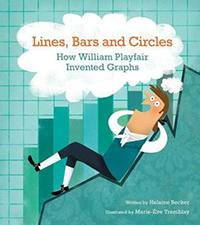Lines, Bars and Circles: How William Playfair Invented Graphs by H. Becker
DOI:
https://doi.org/10.20361/dr29347Abstract
Becker, Helaine. Lines, Bars and Circles: How William Playfair Invented Graphs. Illustrated by Marie-Ève Tremblay. Kids Can Press, 2017.
Lines, Bars and Circles follows the life story of William Playfair. William was a dreamer and he saw the world differently than most people. Born in 1759 in Scotland, William was a joker with a unique sense of humour as a child. As he grew up, his independent spirit led him to leave home at fourteen to seek his fortune. He worked for inventors like William Watt and longed to invent something or make a discovery that would make him rich. Unfortunately, William’s dreaming and scheming did not yield much success and most of his ideas and businesses failed.
William wrote books to make money and while doing so, used his unique way of thinking to describe the information he was writing about. His use of a vertical and horizontal line system to plot results, demonstrated a visual way of displaying numeric values, and thus invented the first line chart. Later he invented the bar graph and the pie chart. Despite interest from the King of France, William’s charts were not taken seriously at first, mostly because of his reputation. It was not until a hundred years after his death that his charts were revisited for their value. In our time, charts and graphs are used in infographics every day, and are greatly valued for their ability to make information easier to understand.
Lines, Bars, and Circles is a great way to introduce both history and mathematics to young readers. The digitally drawn, textured illustrations by Marie-Ève Tremblay bring the 18th century to life with simplicity and whimsy. The Playfair caricature in the book reflects both his creativity and his self-involved personality, aspects of his character that led him to be viewed as uncommitted, ambitious to a fault, and an occupational drifter. Playfair’s story is an interesting one, as it shows how a unique independent spirit can be both a blessing and a curse. The book also shows how not all inventors are fabulously successful, and that one can never know which ideas will be the most impactful. Given the richness of topics in this book it would most suitable for older school age children ages 8-12. Small snippets of historical information are distributed throughout the narrative, about the people William knew and the times he lived in. The end of the book also provides a comprehensive biography of William Playfair. I would recommend this book for children with interests in math and/or history.
Recommended: 3 out of 4 stars
Reviewer: Hanne Pearce
Hanne Pearce has worked at the University of Alberta Libraries since 2004. She holds a BA and MLIS and is currently working towards her Master of Arts in Communications and Technology. Her research interests include: visual communication, digital literacy, information literacy and the intersections between communication work and information work. She is also a freelance photographer and graphic designer.

Published
How to Cite
Issue
Section
License
Authors who publish with this journal agree to the following terms:
- Authors retain copyright and grant the journal right of first publication with the work simultaneously licensed under a Creative Commons Attribution License that allows others to share the work with an acknowledgement of the work's authorship and initial publication in this journal.
- Authors are able to enter into separate, additional contractual arrangements for the non-exclusive distribution of the journal's published version of the work (e.g., post it to an institutional repository or publish it in a book), with an acknowledgement of its initial publication in this journal.
- Authors are permitted and encouraged to post their work online (e.g., in institutional repositories or on their website) prior to and during the submission process, as it can lead to productive exchanges, as well as earlier and greater citation of published work (See The Effect of Open Access).






